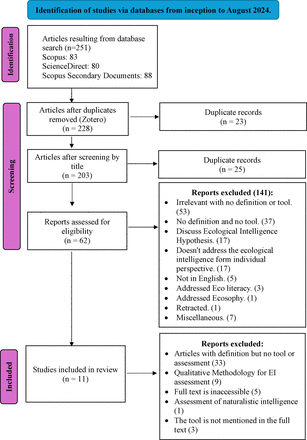Question
The Green Brain Capital Model emphasises the bidirectional relationship between brain health and the environment, making it an environmentally focused type of brain capital. This work represents the initial stage of conceptualising the Green Brain Capital Model, which is essential to avoid ambiguity and misinterpretation while developing a quantitative model. Ecological intelligence (EI) is identified as a key component of the model in the literature. Therefore, the objective of this review was to systematically review the literature to define EI, its features and quantitative assessment tools, to develop comprehensive metrics for Green Brain Capital.
Study selection and analysis
We conducted a search in Scopus, ScienceDirect and Scopus secondary literature and identified 11 articles that provide definitions of EI and quantitative tools to assess it.
Findings
The study revealed that EI is a multifaceted concept with cognitive, affective and behavioural domains. Seven quantitative tools for measuring EI were identified, with the Ecological Intelligence Measurement Tool by Okur-Berberoglu and the Ecological Intelligence Scale by Akkuzu, demonstrating strong theoretical grounding, reliability and validity. Additionally, our review included searching open-access databases provided by reputable organisations, but no indicators for the assessment of EI were found in these databases.
Conclusions
All the available tools were designed to assess EI at the individual level and for research purposes within certain cultural contexts. There is a lack of global indicators reflecting countries’ EI development status and global positioning. Establishing country-level indicators across EI domains is essential for policymaking and public awareness.


